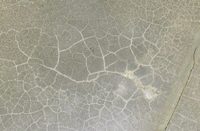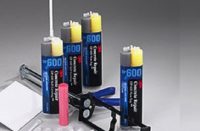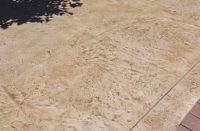
Concrete floors in cold storage operations, such as the freezers in supermarkets, superstores and food and beverage warehouses, have a tough life. Water drippage turns to ice. This constant thermal shift causes the concrete to expand and contract continuously. Over time, this weakens the concrete surface, leading to cracking and decay. The area that damages the quickest is the freezer threshold, which is located at the entrance.
There’s also constant forklift traffic in and out of this door. The big rigs carry heavy loads, and their hard wheels beat up the concrete floor at the threshold. Once the surface starts to deteriorate or become damaged, the destruction will grow if not repaired quickly. The floor will become bumpy and uneven, which could cause forklift accidents and even be unsafe to foot traffic.
Fortunately, there is a solution that can repair the freezer threshold with minimal downtime.

Patch 500 Repair
Patch 500 is a urethane repair material mixed with Patch Crete Course, making it the ideal patching material for minus temperature application. Patch 500 has proven to be a long-term repair solution for freeze thresholds because it can be set up in cold temperatures and will enable the newly repaired floor to be open to traffic after about an hour of downtime. This is critical in high-traffic areas.
Patch 500 has great adhesion, strong durability and a proven track record on freezer thresholds.

Repair Steps
The application process is fast and simple. Proper surface preparation is critical. Follow this six-step process to prepare the surface, apply the repair patch and restore your floor to optimal functionality.
- Identify the extent of the damage. Using a grinder with a diamond blade, cut a half-inch deep slot around the damaged perimeter. Make it a deep cut, not a feather-edge, and make sure you cut into healthy concrete just outside of the perimeter of the damaged area. This is your assurance that you’re taking out all of the problem flooring.
- Break up all of the decayed concrete until you get down to clean, white concrete. You can use a chipping hammer, roto -hammer, or a 30-pound jackhammer. It’s critical that all decayed, discolored concrete is removed, or your patch won’t hold.
- Thoroughly clean up the concrete, grit, dust and other junk with a vaccine cleaner and inspect for weak, discolored spots. That’s damaged concrete that hasn’t yet been removed.
- Mix batches of Patch 500 with Patch Crete Course to fill in the chipped-out area. The batch ratio is one part A, one part B, and two to three parts of Patch Crete Course. The consistency should be flowable.
- Fill the patch area with the Patch 500 solution, using a long straight edge or trowel to spread it flush with the surrounding concrete.
- Use a surface grinder to smooth out any trowel marks or ridges, if needed.
That’s it. After only about two hours of downtime, you can open the area to foot and forklift traffic.

Other Applications for Patch 500
Patch 500 is great for freezers because it can be used at minus-zero temperatures. But the product can also be used in normal-temperature interior surfaces and even outdoors. It’s ideal for any concrete floor repair issue, like filling spalls and holes, due to its ability to bind to the surrounding concrete, making it very durable and a superfast cure.
Joint Filler Solution
The metal isolation track that separates freezer concrete from the exterior flooring can also give forklifts a bumpy ride. It collects debris, too. So there’s SP 100, a joint filler compound with 300 percent elongation and 86 shore A hardness. It’s ideal for filling in the isolation tack for a smoother transition at the doorway.
When using SSP 100, first make sure that the joint is clean. The most convenient method is to fill the track using an SSP 100 cartridge gun. Traffic will be able to go over the joint in 30 minutes.
Looking to patch your concrete?
Offered by Concrete Decor Store Patch Crete Pure
Patch Crete Pure
by Solid Solution Products Camo Patch UV (formerly SPEC-UVR)
Camo Patch UV (formerly SPEC-UVR)
by Solid Solution Products












